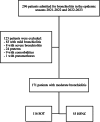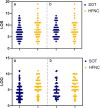High-flow nasal cannulas versus standard oxygen therapy for moderate bronchiolitis: a quasi-experimental analysis
- PMID: 39451018
- PMCID: PMC11740650
- DOI: 10.1002/ppul.27358
High-flow nasal cannulas versus standard oxygen therapy for moderate bronchiolitis: a quasi-experimental analysis
Abstract
Background: In the last decades none of the medical therapies investigated have shown clear efficacy in the treatment of bronchiolitis, and literature agrees on a general de-implementation of pharmacological therapies, recognizing an effective role only to nutritional support and oxygen therapy. High-flow nasal cannulas (HFNC) has become increasingly popular in the last decade, despite its lack of clear efficacy. Recent randomized controlled trials (RCT) comparing standard oxygen therapy (SOT) and HFNC did not demonstrate significant benefit of HFNC. To acquire more clinical data on HFNC efficacy we performed a retrospective, quasi-experimental analysis of patients admitted for bronchiolitis in the epidemic seasons 2021-2022 and 2022-2023.
Methods: To assess the efficacy of SOT and HFNC we used a pragmatic approach, a fuzzy regression discontinuity design, which is a quasi-experimental test. Unlike RCTs, this process is not a true randomization, but may be interpreted as quasi-randomization in an observational setting.
Results: HFNC did not reduce length of oxygen therapy (LOO) nor length of hospitalization (LOS) (respectively, p: 0.383 and p: 0.454). Treatment failure was not significantly different in the treatment groups (p: 0.354).
Conclusions: It is crucial to perform additional RCTs with uniform protocols to determine the efficacy of HFNC more accurately in the treatment of bronchiolitis. HFNC does not reduce LOO, suggesting that early use of HFNC does not change the course of disease in moderate bronchiolitis. In view of the greater complexity and higher cost, HFNC should not be routinely used as first-line treatment in children with moderate respiratory distress and mild hypoxemia.
Keywords: RSV; bronchiolitis; high‐flow nasal cannulas; standard oxygen therapy.
© 2024 The Author(s). Pediatric Pulmonology published by Wiley Periodicals LLC.
Conflict of interest statement
The authors declare no conflict of interest.
Figures




References
Publication types
MeSH terms
Grants and funding
LinkOut - more resources
Full Text Sources
Medical

